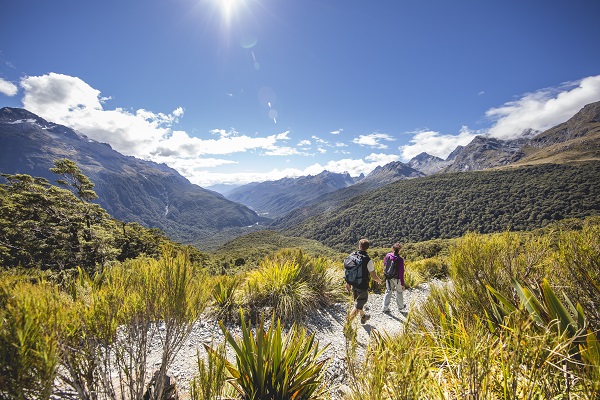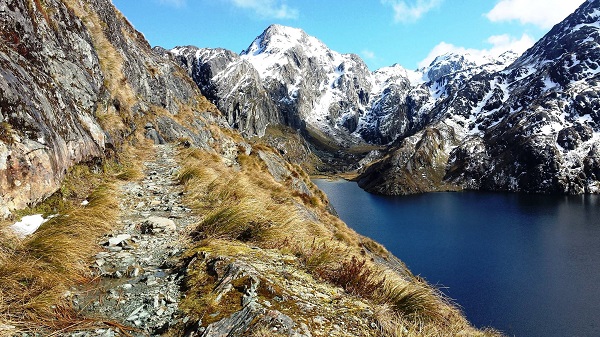When you’re planning something as special as a hiking trip in New Zealand, no doubt you’ll be keen to learn more about New Zealand’s seasons and weather patterns before deciding when to book your hike. Knowing what the weather is likely to be doing before you lace up the boots is a great way to be prepared – after all, one of the reasons you want to head out hiking is probably to enjoy our beautiful outdoors!
Here at Easyhike, When is the best time for hiking in New Zealand is a question we get asked a lot. Below, we’ve put together the low-down on New Zealand’s seasons – along with some friendly local tips – to help you plan your hiking trip in New Zealand.
One of the cool things about our little country is that it’s possible to explore our national parks on foot at any time of the year. But there’s no doubt about it; different times of year definitely do bring different New Zealand hiking experiences.
Hiking in New Zealand during Spring
Keep in mind that New Zealand is in the Southern Hemisphere, so if ‘home’ for you is further north, all of our seasons are the opposite of our Northern Hemisphere friends.
Officially, Spring lasts from 1 September to the end of November – but often, Spring weather hangs around well into December. It feels like the whole of New Zealand breathes a sigh of relief when Spring hits – it’s a very uplifting, positive time of year to head outdoors; think new plant growth, longer daylight hours, baby lambs and cows in the fields and lush greenery.
Up in Auckland, average Spring temperatures sit at around 17-19°C (62 – 66 °F); but further south in Queenstown (one of the nearest cities to popular tracks like the Milford, Routeburn and Kepler) it’s a bit chillier; generally around 15°C (59°F).
Spring can bring more rain than other seasons, especially in Fiordland where the Kepler & Milford Tracks are. But as long as you’re prepared, rain can actually enhance your hike – the Milford Track comes alive during wet weather; think waterfalls plummeting down cliff tops and misty, Middle-earth like rainforests.
Spring hiking tips: Don’t let the prospect of rain put you off hiking during Spring – with good quality and lightweight waterproof gear, you may not even notice the rain (often the weather forecast isn’t accurate anyway). The tracks are generally quieter during this time of year as well, meaning you’re likely to get long sections all to yourself!
Hiking in New Zealand during Summer
As you’d expect, summer is a pretty magical time of year here in NZ. Kiwi’s swap shoes for Jandals (a type of sandal), our pohutukawa trees blossom into bring red flowers and the days get really, really long – sometimes, darkness doesn’t hit till 10pm! A summer holiday vibe spreads throughout the country and we (generally) start to enjoy more settled periods of dry, fine weather.
Summer ‘officially’ is from December to February (yep, we celebrate Christmas when it’s hot outside) but it’s often Jan & Feb that are the best months for ‘classic’ summer weather.
Up in Auckland, the average temperature in summertime sits at around 24°C (a balmy 75°F). Further south in Queenstown (near where we live), it’s usually around 20°C (68°F).
Do keep in mind that New Zealand holiday spots and hiking trails get pretty busy during the summer months. You’ll need to book and plan your time on the track well in advance, and be prepared to see a fair few people. That said, many hikers say that they enjoy the companionship out on NZ’s trails – there’s a lovely, friendly vibe out there.
Summer hiking tips: Don’t forget the camera – out on the Routeburn, Milford and Kepler, summer is your best chance for those clear, blue-sky days where you can see for miles! While summer is the warmest time of year, it’s not usually overly humid. Make sure to bring good sunscreen and a comfortable hat for sections of track where you’re above the bush line.
Hiking in New Zealand during Autumn
The most colourful time of year, Autumn (fall) runs between March and May. Autumn is pure magic in places like Queenstown, Wanaka and Arrowtown – think trees decked out in various hues of gold, orange and red, and beautiful blue-sky days. While Autumn is known for being a little cooler, locals also know it often means very settled weather.
It’s also not nearly as busy as the summer months, so if you like a bit of solitude then this could be the season to plan your New Zealand hike. Generally, the ocean and lakes hold their warm temperatures from summer, so if you like to cool off with a dip, Autumn still offers comfortable (albeit refreshing) swimming opportunities.
Auckland’s Autumn days sit around 21°C (68°F) while we usually get averages of 15 or 16 (59 or 61°F) down here in Queenstown.
Autumn hiking tips: This is an absolute favourite time of year to get out and explore on foot. There are usually plenty of birds around during Autumn as well – our National Parks are full of lively natives. While the temperatures are cooler, make sure you still pack the sunscreen.
Hiking in New Zealand during Winter
When you think about hiking, you might not automatically think ‘winter’ – and while the cooler months are not an especially popular time to explore on foot, the experience you’ll get on some trails is markedly different to other times of year. Do keep in mind that many of our Great Walks are ‘closed’ during the winter season, which means huts are not serviced, and many bridges get taken down in case of weather hazards.
Winter officially runs between June and August, but can sometimes run over into September, especially in mainland South Island. We’re pretty lucky that all of our native forests are evergreen – forget walking through a barren environment of sticks and twigs! And because there’s hardly anybody around during this time of year, you’ll have Mother Nature pretty much all to yourself.
For many places in the country, winter can mean snowfall – so be prepared for last-minute changes of plan if the track you had your eye on gets closed due to avalanche risk last-minute. Or, consider one of the Great Walks that aren’t affected by snowfall – the Heaphy (West Coast South Island), Abel Tasman (tip of the North Island) or Lake Waikaremoana (Mid-Eastern North Island) are all good options during winter.
Winter hiking tips: Don’t use winter as an excuse to hibernate – as long as you plan in advance and have all the right gear, you’ll have an awesome time outdoors. However, it definitely pays to choose your track carefully. The Routeburn, Milford or Kepler tracks probably aren’t good winter hiking options unless you are well-experienced and equipped with avalanche safety skills and equipment. You’ll also find winter travel in NZ a little bit cheaper, as long as you stay outside of the ski resorts.
Planning your New Zealand independent hiking adventure
So now you know all about New Zealand’s weather and seasons, you might be feeling a little more confident about booking your Great Walk down under! Don’t let the logistics of a multi-day hike put you off, especially if you’re coming from far away. Leave it to the locals – let us lend you our quality hiking gear, book your hut tickets, organize delicious food and relocate your rental car while you’re on the trail – so you can put all of your energy into your New Zealand hike. Easy!

